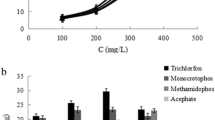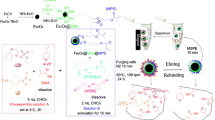Abstract
A fast and economical method has been developed for the preconcentration of the carbamates propoxur, pirimicarb and promecarb by using magnetic molecularly imprinted polymers (m-MIPs). Propoxur was applied as the template for the analytes, and carbon nanotubes as a supporting template. The effects of the amount of magnetic sorbent, shaking time and rate, eluting solution on the extraction efficiency were studied. The processes of adsorption and desorption occur within 25 min, and the m-MIPs can be collected by applying an external magnetic field within 15 s. The m-MIPs were characterized by using FTIR, transmission electron microscopy, and with a vibrating sample magnetometer. The pesticides were quantified by HPLC with UV detection. Recoveries of spiked samples range from 90.5 to 98.6 %, and the lower detection limits range from 9.7 to 12.0 μg kg−1. The method is selective and convenient. The m-MIPs were successfully applied to enrich and determine the carbamates in spiked homogenates of apples, oranges and pears.

Extraction process using magnetic molecularly imprinted polymers. The m-MIPs were prepared using proporxur as the template molecular, carbon nanotubes as supporter and Fe3O4 as the magnetic component. The m-MIPs were successfully applied to determine the carbamates in fruit samples with recoveries that range from 90.5 to 98.6 %.



Similar content being viewed by others
References
Fernández M, Picó Y, Mañes J (2000) Determination of carbamate residues in fruits and vegetables by matrix solid-phase dispersion and liquid chromatography–mass spectrometry. J Chromatogr A 871(1–2):43–56
Peng S, Xiao J, Cheng J, Zhang M, Li X, Cheng M (2012) Ionic liquid magnetic bar microextraction and HPLC determination of carbamate pesticides in real water samples. Microchim Acta 179(3–4):193–199
Ma X, Wang J, Wu Q, Wang C, Wang Z (2014) Extraction of carbamate pesticides in fruit samples by graphene reinforced hollow fibre liquid microextraction followed by high performance liquid chromatographic detection. Food Chem 157:119–124
Santalad A, Srijaranai S, Burakham R, Glennon JD, Deming RL (2009) Cloud-point extraction and reversed-phase high-performance liquid chromatography for the determination of carbamate insecticide residues in fruits. Anal Bioanal Chem 394(5):1307–1317
Zhang T, Ma C, Wu M, Ye Y, Chen H, Huang J (2013) Selective microextraction of carbaryl and naproxen using organic–inorganic monolithic columns containing a double molecular imprint. Microchim Acta 180(7–8):695–702
Zhou S, Chen H, Wu B, Ma C, Ye Y (2011) Sensitive determination of carbamates in fruit and vegetables by a combination of solid-phase extraction and dispersive liquid-liquid microextraction prior to HPLC. Microchim Acta 176(3–4):419–427
Goto T, Ito Y, Yamada S, Matsumoto H, Oka H, Nagase H (2006) The high throughput analysis of N-methyl carbamate pesticides in fruits and vegetables by liquid chromatography electrospray ionization tandem mass spectrometry using a short column. Anal Chim Acta 555(2):225–232
Granby K, Andersen JH, Christensen HB (2004) Analysis of pesticides in fruit, vegetables and cereals using methanolic extraction and detection by liquid chromatography–tandem mass spectrometry. Anal Chim Acta 520(1–2):165–176
Liu M, Hashi Y, Song Y, Lin JM (2005) Simultaneous determination of carbamate and organophosphorus pesticides in fruits and vegetables by liquid chromatography-mass spectrometry. J Chromatogr A 1097(1–2):183–187
Lachenmeier DW, Nerlich U, Kuballa T (2006) Automated determination of ethyl carbamate in stone-fruit spirits using headspace solid-phase microextraction and gas chromatography-tandem mass spectrometry. J Chromatogr A 1108(1):116–120
Chen L, Zhang X, Xu Y, Du X, Sun X, Sun L, Wang H, Zhao Q, Yu A, Zhang H, Ding L (2010) Determination of fluoroquinolone antibiotics in environmental water samples based on magnetic molecularly imprinted polymer extraction followed by liquid chromatography-tandem mass spectrometry. Anal Chim Acta 662(1):31–38
Wulff G (2013) Fourty years of molecular imprinting in synthetic polymers: origin, features and perspectives. Microchim Acta 180(15–16):1359–1370
Chen X, Zhang Z, Yang X, Li J, Liu Y, Chen H, Rao W, Yao S (2012) Molecularly imprinted polymers based on multi-walled carbon nanotubes for selective solid-phase extraction of oleanolic acid from the roots of kiwi fruit samples. Talanta 99:959–965
Apodaca DC, Pernites RB, Ponnapati R, Del Mundo FR, Advincula RC (2011) Electropolymerized molecularly imprinted polymer film: EIS sensing of bisphenol A. Macromolecules 44(17):6669–6682
Huang J, Zhang X, Lin Q, He X, Xing X, Huai H, Lian W, Zhu H (2011) Electrochemical sensor based on imprinted sol–gel and nanomaterials for sensitive determination of bisphenol A. Food Control 22(5):786–791
Kubo I, Yokota N, Fuchiwaki Y, Nakane Y (2012) Characteristics of molecularly imprinted polymer thin layer for bisphenol A and response of the MIP-modified sensor. ISRN Mater Sc 2012:1–6
Zhang M, Huang J, Yu P, Chen X (2010) Preparation and characteristics of protein molecularly imprinted membranes on the surface of multiwalled carbon nanotubes. Talanta 81(1–2):162–166
Ma G, Chen L (2014) Development of magnetic molecularly imprinted polymers based on carbon nanotubes — application for trace analysis of pyrethroids in fruit matrices. J Chromatogr A 1329:1–9
GB/T 19648–2006 method for determination of 500 pesticides and related chemicals residues in fruits and vegetables-GC-MS method
Cheng J, Zou XP, Zhu G, Wang MF, Su Y, Yang GQ, Lü XM (2009) Synthesis of iron-filled carbon nanotubes with a great excess of ferrocene and their magnetic properties. Solid State Commun 149(39–40):1619–1622
Liu Q, Chen Z-G, Liu B, Ren W, Li F, Cong H, Cheng H-M (2008) Synthesis of different magnetic carbon nanostructures by the pyrolysis of ferrocene at different sublimation temperatures. Carbon 46(14):1892–1902
Gao R, Kong X, Su F, He X, Chen L, Zhang Y (2010) Synthesis and evaluation of molecularly imprinted core-shell carbon nanotubes for the determination of triclosan in environmental water samples. J Chromatogr A 1217(52):8095–8102
Xu L, Pan J, Dai J, Li X, Hang H, Cao Z, Yan Y (2012) Preparation of thermal-responsive magnetic molecularly imprinted polymers for selective removal of antibiotics from aqueous solution. J Hazard Mater 233–234:48–56
Hirano A, Uda K, Maeda Y, Akasaka T, Shiraki K (2010) One-dimensional protein-based nanoparticles induce lipid bilayer disruption: carbon nanotube conjugates and amyloid fibrils. Langmuir : ACS J Surf Colloids 26(22):17256–17259
Zhang Z, Zhang H, Hu Y, Yang X, Yao S (2010) Novel surface molecularly imprinted material modified multi-walled carbon nanotubes as solid-phase extraction sorbent for selective extraction gallium ion from fly ash. Talanta 82(1):304–311
Gao N, Xu Z, Wang F, Dong S (2007) Sensitive biomimetic sensor based on molecular imprinting at functionalized indium tin oxide electrodes. Electroanalysis 19(16):1655–1660
Chen FF, Xie XY, Shi YP (2013) Preparation of magnetic molecularly imprinted polymer for selective recognition of resveratrol in wine. J Chromatogr A 1300:112–118
Kong X, Gao R, He X, Chen L, Zhang Y (2012) Synthesis and characterization of the core-shell magnetic molecularly imprinted polymers (Fe(3)O(4)@MIPs) adsorbents for effective extraction and determination of sulfonamides in the poultry feed. J Chromatogr A 1245:8–16
Ibarra IS, Miranda JM, Rodriguez JA, Nebot C, Cepeda A (2014) Magnetic solid phase extraction followed by high-performance liquid chromatography for the determination of sulphonamides in milk samples. Food Chem 157:511–517
Wang B, Wang Y, Yang H, Wang J, Deng A (2011) Preparation and characterization of molecularly imprinted microspheres for selective extraction of trace melamine from milk samples. Microchim Acta 174(1–2):191–199
Hu C, Deng J, Zhao Y, Xia L, Huang K, Ju S, Xiao N (2014) A novel core-shell magnetic nano-sorbent with surface molecularly imprinted polymer coating for the selective solid phase extraction of dimetridazole. Food Chem 158:366–373
Barri T, Trtic-Petrovic T, Karlsson M, Jonsson JA (2008) Characterization of drug-protein binding process by employing equilibrium sampling through hollow-fiber supported liquid membrane and Bjerrum and Scatchard plots. J Pharm Biomed Anal 48(1):49–56
Shui G, Leong LP (2002) Separation and determination of organic acids and phenolic compounds in fruit juices and drinks by high-performance liquid chromatography. J Chromatogr A 977(1):89–96
EC Council Directive, Informal coordination of MRLs established in Directives 76/895/EEC, 86/362/EEC, 86/363/EEC, and 90/642/EEC
Acknowledgments
This work was supported by the National Natural Science Foundation of China (No. 21205010).
Author information
Authors and Affiliations
Corresponding author
Electronic supplementary material
Below is the link to the electronic supplementary material.
ESM 1
(PDF 271 kb)
Rights and permissions
About this article
Cite this article
Gao, L., Chen, L. & Li, X. Magnetic molecularly imprinted polymers based on carbon nanotubes for extraction of carbamates. Microchim Acta 182, 781–787 (2015). https://doi.org/10.1007/s00604-014-1388-1
Received:
Accepted:
Published:
Issue Date:
DOI: https://doi.org/10.1007/s00604-014-1388-1




